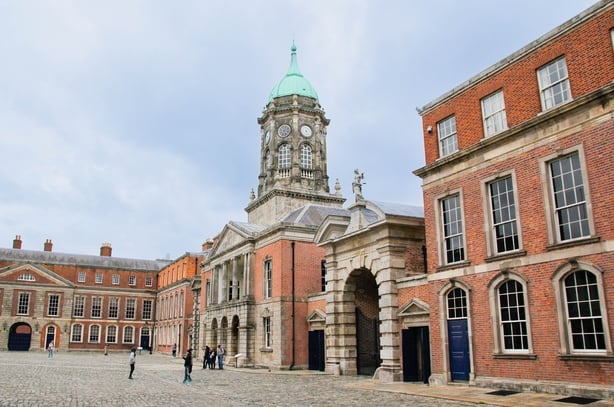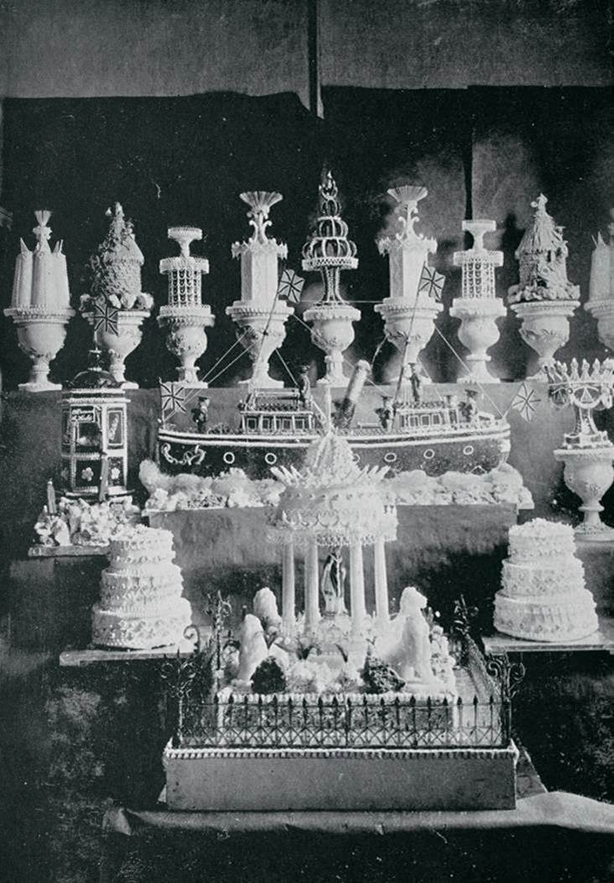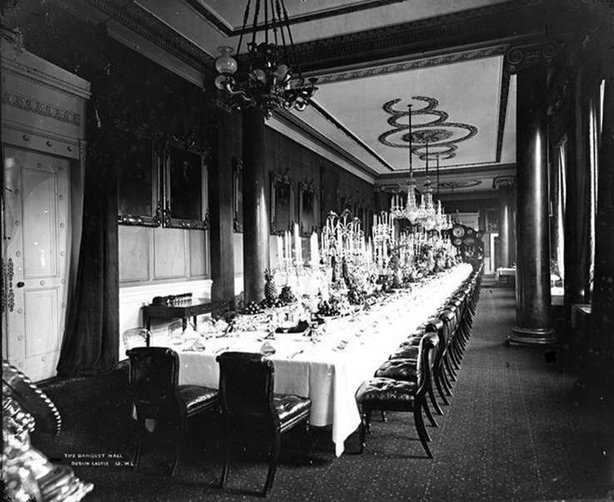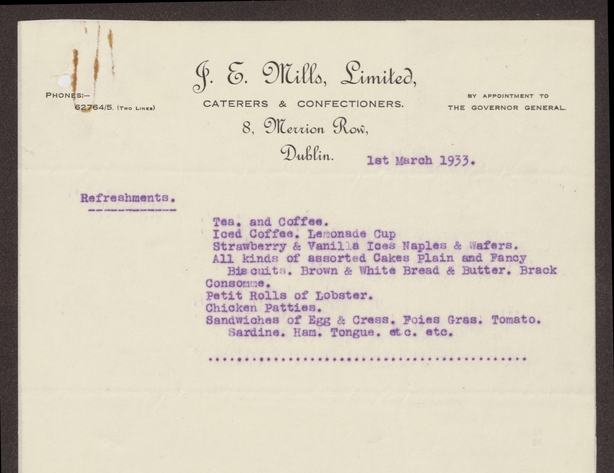Analysis: From the frolics of the St. Patrick's Ball to the Eucharistic Congress, Dublin Castle has hosted colourful and important events on March 17th
By Elaine Mahon, TU Dublin and William Derham, Dublin Castle
Dublin Castle occupies a long and complicated position in Irish history. Best known for its associations with colonialism and war, what Michael Collins called Ireland's 'Dread Bastille’ was also at one time the centre of Dublin society, and is today more associated with popular referendum results and Irish state hospitality.
How the Castle was used, by lords lieutenant or viceroys before 1922 and by the Irish state afterwards, provides some interesting comparisons on state entertaining and celebrating St Patrick’s Day over the last 200 years. In the 19th and early 20th centuries, the St Patrick’s Day ball was the culmination and highlight of the Castle Season, a six-to-eight-week programme of formal dinners, presentations, select suppers and evening dances.

Throughout that particular day, the Upper Castle Yard was host to brass military bands and troops on horseback parading and performing manoeuvres, all watched by an eager public. From the (long-gone) balcony of the State Apartments, the Viceroy appeared with family and friends and waved to the crowds. Commenting in 1898, Frances Gerard in Picturesque Dublin, Old and New noted that "some of the ladies wear green frocks, or perhaps green hats, which now are the fashion; the Viceroy sports an exceedingly unbecoming green tie; and everyone is decorated with a large bunch of the national emblem."
When the day-long festivities in the Upper Yard came to an end, the entertaining continued within. "Far greater fun reigns at night, when a banquet is given at the Castle, and later in the evening the time-honoured "St. Patrick’s Ball." This is given in the hall of that name, which hardly holds the crowd of dancers.
"As the season closes with this entertainment, a sort of general license prevails, and the Chamberlain, that awful personage who holds in his hand the sesame to the Castle festivities, relaxes for this night only his unusually stern morality. Fast and furious grows the fun, and so too the flirtations, many a halting lover being helped over the bridge which separates flirtation from matrimony by the kindly influence of the patron saint, aided by the Viceroy’s champagne."

The large formal rooms of the State Apartments can suggest the setting of poised and formal gatherings, ceremonies and solemnities, but as the above description shows that was not always the case. At the heart of state entertaining, both pre- and post-independence, was the very Irish notion of hospitality.
At the centre of such hospitality were food, drink, entertainment and largesse, and indeed this hospitality was very much an Irish characteristic. In Royal Pomp: Viceregal Celebrations and Hospitality in Georgian Dublin (2011) Máirtín Mac Con Iomaire and Tara Kellaghan note that "commentary by contemporaneous English observers supports the proposition that the ruling class emulated the native Irish in their displays of generous hospitality; English visitors invariably remarked upon the overwhelming level of Irish hospitality in comparison to the prevailing English norms."
The historical records are littered with references to bands playing music, dancing into the early hours and wine and food served in abundance (though, sadly, very few itemised menus). A rare illustration of such hospitality survives in the form of a photograph from the viceroyalty of the Earl of Aberdeen, who served in Dublin from 1905 to 1915. It shows a display of ‘Confections devised by Chef Thévin for St. Patrick’s Ball’ and gives some idea of the (literal) conspicuous consumption at the heart of Irish hospitality.
From British Pathé, Dublin Castle is handed over to the Irish Government in 1922
All of this is in contrast to the role the Castle played in Irish life in the first years of independence. For almost a decade, the Four Courts sat in the State Apartments and that section of the Castle was out-of-bounds for use by the new administration. In the absence of state reception rooms, the Cumann na nGaedheal government led by William Cosgrave entertained at different locations throughout Dublin city centre.
Venues included the Metropole Ballroom, Cinema and Restaurant, the Gresham Hotel, The Plaza on Middle Abbey Street, the Royal Hibernian Hotel, the Mansion House, the Shelbourne (which was a particular favourite), and the National Museum of Ireland on Kildare Street. It was only when the law courts officially re-opened in the Four Courts on Inns Quay in October 1931, several months prior to Fianna Fáil coming to power, that the State Apartments became available for use by the Irish government.
When Éamon de Valera took office in March 1932, preparations for the government reception during the 1932 Eucharistic Congress were at full tilt. The venue had not yet been confirmed although a number of potential locations had been considered and then abandoned for various reasons. These included the grounds of the Viceregal Lodge, the Royal Dublin Society in Ballsbridge and The Plaza Hotel on O’Connell Street.

De Valera decided that the Castle would be reinstated for use as an official state venue, thus reappropriating the building that had symbolised British presence in Ireland for so long. The Castle was given the ‘greatest spring clean in its history’ according to the Irish Times and began its new role by hosting the reception offered by the Irish government under the direction of the Archbishop of Dublin Edward Byrne during the 1932 Eucharistic Congress.
The first official event at Dublin Castle hosted by the Irish Government was a state reception held in honour of the Diplomatic and Consular Corps which took place on St. Patrick’s Day 1933. It was the first time that the Castle would be used on St. Patrick’s Day since the establishment of the Irish Free State, a date which traditionally marked the close of the Viceregal season and had been home to the frivolities and festivities described above.
St. Patrick's Hall, the Picture Gallery, the Drawing Rooms and the State Corridor were to be used for the reception and required a thorough deep-clean, as did all of the access areas, the outer hall, corridors and cloakrooms, main hall, staircase and the landing. The heating and electricity were checked throughout. Red felt was laid in St. Patrick’s Hall and the Picture Gallery as well as on the stairs and landing. Curtains were hung on the windows in St. Patrick’s Hall and above the staircase.
We need your consent to load this rte-player contentWe use rte-player to manage extra content that can set cookies on your device and collect data about your activity. Please review their details and accept them to load the content.Manage Preferences
From RTÉ Archives, Vere Wynn Jones reports for RTÉ News in 1986 on the discovery of over 100,000 artefacts from medieval times, including remains of Viking Dublin, during archaeological excavations in the grounds of Dublin Castle
The Drawing Room was furnished and recarpeted. Furniture that had been on loan to the Lord Mayor of Dublin Alfie Byrne for an event at the Mansion House was taken out of storage and cleaned before being returned to the appropriate rooms in the Castle. A small circular room off St. Patrick’s Hall, known today as the Gothic Supper Room, was designated as a kitchen and the gas cookers supplied by the caterer were connected to the mains by OPW technicians.
The caterer was J.E. Mills of Merrion Row, Dublin, the same firm that had catered the government reception during the Eucharistic Congress. The menu offered in honour of the Diplomatic and Consular Corps featured the usual staples such as a variety of non-alcoholic beverages, sandwiches, ice creams and assorted cakes. Alcoholic beverages such as ‘claret, sauterne and cider cups’ were billed separately and based on the amount consumed.
This particular menu was a little different as it also included high-status items such as consommé, lobster, foie gras and coffee which were costly, technical, seasonal or highly regulated which tells us that this was a prestigious menu for prestigious guests. The menu, at 3s.6d. per person (approximately €18.70 today), was more expensive than the menu served at the government reception during the Eucharistic Congress, which had cost 2s.6d. per person (approximately €13.36 today).

According to newspaper reports, the occasion was a great success and on a par with the festivities as well as elements of the formality of times past. On his arrival, de Valera was received by a Guard of Honour of the Second Infantry Battalion, while the Army Band played A Soldier's Song. He then inspected the guard and, as he entered the main hall of the State Apartments, de Valera was given the salute by a platoon of members from the Blue Huzzars ‘clad in the striking dress uniforms of blue, with yellow pipings, stood to attention with drawn swords on the grand staircase.’
"The historic St. Patrick’s Hall, and the State Apartments of Dublin Castle recaptured something of their old glory last night when they were the scene of a State reception given by Mr. de Valera, President of the Executive Council. Naturally it awakened memories of those brilliant State functions which of old were held here on the feast day of the national patron. So far as outward appearances went there was little change from the conditions of old."
Thus began Dublin Castle’s role as Ireland’s first designated state reception room post-independence. During the 1930s, de Valera would entertain state guests, diplomatic envoys and important visitors there, reinforcing its status at the centre of official Irish state hospitality. By 1941, the number of state venues for official entertaining had expanded to include Aras An Uachtaráin and Iveagh House. Dublin now had a suite of reception rooms which would form the core of state hospitality for the next half century where food and hospitality would remain central elements to Irish national identity, whether on St Patrick’s Day or any other day of the year in the official state calendar.
Follow RTÉ Brainstorm on WhatsApp and Instagram for more stories and updates
Dr Elaine Mahon is a Lecturer in Gastronomy and Food Studies in the School of Culinary Arts and Food Technology at TU Dublin. William Derham is an author, building historian and researcher who works as Curator of Buildings at Dublin Castle for the Office of Public Works
The views expressed here are those of the author and do not represent or reflect the views of RTÉ

